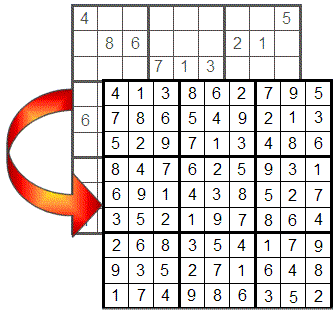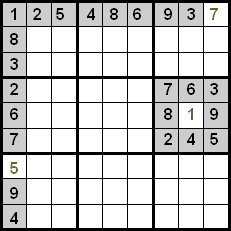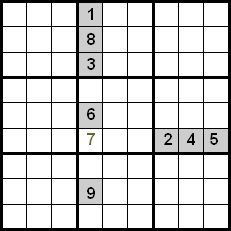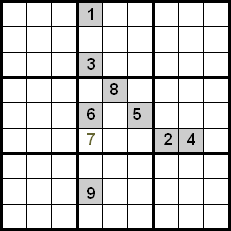Techniques
The best techniques, tips and tricks to solve sudokus

First Tips
Let's start by reviewing the basic rules of the game:
Sudoku consists of a 9x9 grid, divided into 9 3x3 quadrants, which must be filled so that all rows, columns and quadrants have the numbers from 1 to 9 without repetition.
In this first lesson we will present some useful tips when solving sudokus.
- Use a pencil:It is much more comfortable to do a sudoku in pencil than on a computer screen. Also, the pencil allows you to erase it in a simple way.
- Practice gradually:Usually many newspapers and magazines do not catalog sudokus by difficulty so, for a neophyte, it can be really complicated to finish a complex sudoku. At PrintSudoku.com we catalog sudokus so that you practice with sudokus according to your level. The higher the level, the harder it will be (usually) to put the numbers and, in the case of very difficult ones, sometimes you will have to try moves.
- To try moves there is nothing better than writing the candidate numbers in the upper left corner of the cell. If you write small or in a margin, as you discard numbers, cross them out.
- Take it easy:sudoku is a relaxed game. Some sudokus can be solved in a matter of minutes but others may take you hours or maybe days.
- Well-designed sudokus have a unique solution, use this feature to your advantage.
- Never try until you have finished carefully examining all possible moves.
- Follow an order:in placing the numbers, a good tactic is to start with the numbers that appear most frequently ending with the least frequent ones; in case of ties decide the order and follow it throughout the game.
- Check that each step you take is valid, a mistake at the beginning can be disastrous.
- If you can't find a possible solution ask for help, or try the sudoku at another time. Many times the solution appears when you least expect it, and not always when you are in front of the sudoku. 😉
Basic Method
The easiest way to discover a number is when there is only one number left to put in a row, column or quadrant. In this case the missing number goes in the only empty cell left.

As you can see, all numbers except 7 are placed in the first row, so only this number can go in the empty cell. Something similar happens in the first column with 5, as well as in the sixth quadrant with 1.
Row and Column Cross
Another way to discover numbers is to make a cross by row and column. This consists of focusing attention on a cell and checking what numbers can go in that position, eliminating those that are in the same row or column.
In the following image we can verify that only 7 can go in the indicated cell, since the numbers 1, 8, 3, 6 and 9 are in the same column and the numbers 2, 4 and 5 in the same row.

An improvement of this technique is achieved by also controlling the numbers that are in the same quadrant. In the following example we can see that using the cross between rows and columns we would have candidates numbers 5, 7 and 8 to place them in the marked cell. Since numbers 5 and 8 are already placed in their positions within the quadrant, we can discard them, so number 7 is the one that occupies the indicated position.

Swordfish
The Swordfish technique is used in sudokus when a specific number appears as possible in exactly three rows and three columns.
💡 Practical Tip: For example, if the number 5 can only appear in columns 2, 5 and 8 of three different rows, a Swordfish pattern is formed. Here, if 5 cannot be in any other cell of those rows outside of columns 2, 5 and 8, then 5s can be eliminated as possibilities in those columns of other rows.
This method is especially useful for unlocking stalled situations in an advanced game. In a practical case, if you observe that in rows 1, 4 and 7, the number 5 can only go in the same three columns, you have identified a Swordfish. Now you can safely eliminate the number 5 from columns 2, 5 and 8 in all other rows, which often clears multiple cells and facilitates the solution of the rest of the sudoku.
XYZ-Wing
XYZ-Wing focuses on finding three cells that form a connection, where two have two possible numbers and the third (pivot) shares a number with each of the other two.
📝 Example: Suppose three cells where one has options 1 and 2, another 1 and 3, and the pivot 1, 2, 3. This configuration allows eliminating the number 1 from other cells that are seen by all three, since 1 must occupy one of them, thus clarifying the options in those areas.
In practice, if you find this configuration in a sudoku game, an opportunity opens up to significantly reduce the possibilities. By applying the XYZ-Wing technique, you can eliminate options strategically, facilitating the resolution of the most complex parts of the puzzle.
Dual Linking
The dual linking technique is applied when two numbers can only go in two cells of a row, column or block, and these cells do not contain other numbers.
✨ Advantage: By solving one of the numbers, the position of the other is automatically solved. This technique is effective for eliminating options in areas where numbers are strongly interconnected.
Imagine a sudoku where in a specific row, only cells A2 and A8 can contain the numbers 3 and 7. If we solve that A2 must contain 3, we automatically know that A8 must contain 7.
Box Line Reduction
The box line reduction technique is an advanced strategy that is used when the possible locations of a number in a row or column are completely within a single region or box.
🔧 Application: By identifying this configuration, you can eliminate that number from the possible locations in other cells of the same box that are not in the specific row or column.
For example, if in an upper box the numbers 4 can only appear in cells that are part of row 2, then you can eliminate 4 as a possibility in the other cells of that box. This technique improves efficiency when solving complex sudokus.
Do you know more techniques?
If you know any additional techniques for solving sudokus that we haven't mentioned, we'd love to hear from you. Your knowledge could help other sudoku enthusiasts improve their skills.